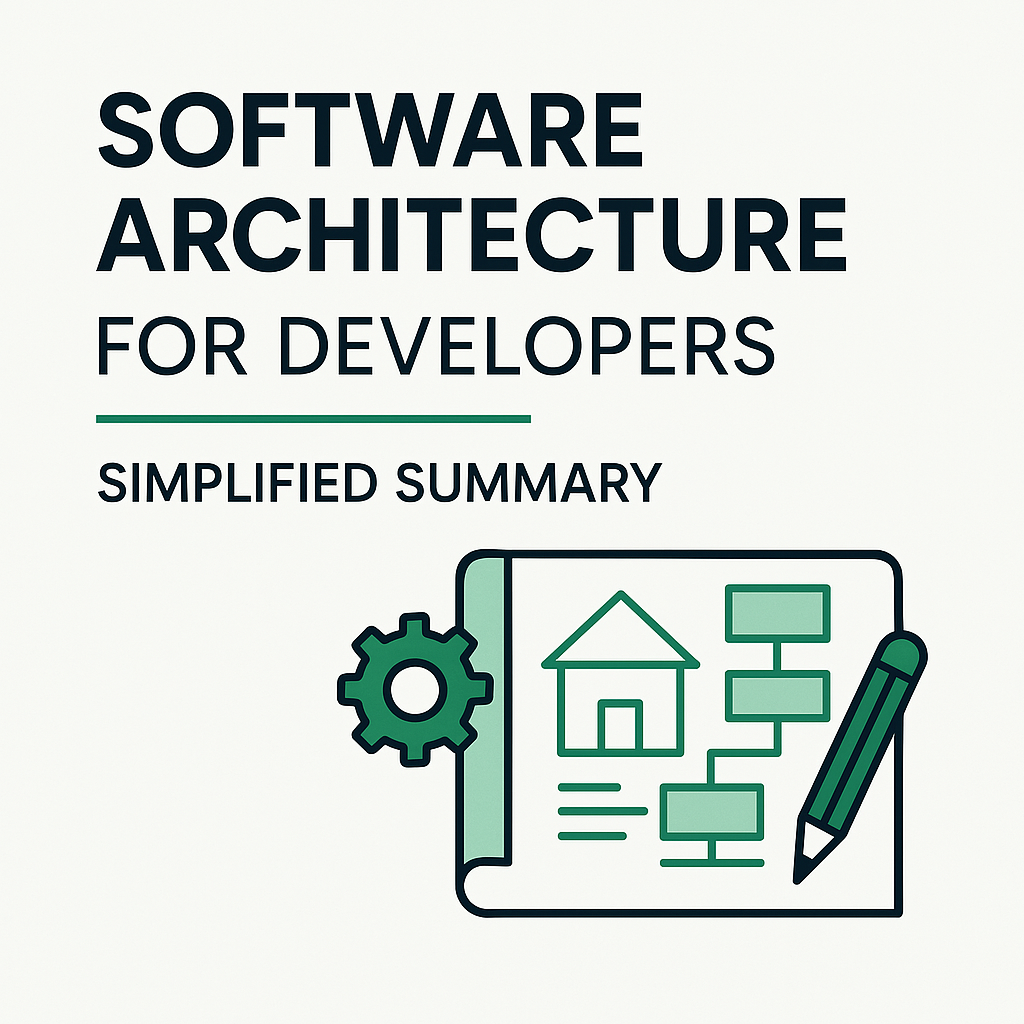Software Architecture for Developers – Simplified Summary (By Simon Brown)
This summary breaks down Simon Brown’s “Software Architecture for Developers” in a simple, blog-friendly format, focusing on the core concepts, practical advice, and real-world relevance. It’s ideal for developers who want to transition into architectural roles or simply build stronger software systems.

📘 Section 1: What is Software Architecture?
Key Concepts:
- Definition: Software architecture is about structure, decisions, and communication. It defines the high-level shape of the software.
- Importance: It’s not just about diagrams or buzzwords. Good architecture enables agility, maintainability, scalability, and team alignment.
Common Mistake:
Many teams start building systems without consciously thinking about architecture. This leads to technical debt and rework.
Real-World Example:
If you’re building a house, architecture is like the blueprint—it guides construction, avoids chaos, and ensures stability.
🧠 Section 2: The Role of the Software Architect
Key Concepts:
- Types of Architects:
- Ivory Tower Architect: Detached, doesn’t code. Not ideal.
- Pragmatic Architect: Involved, helps teams, writes code when needed.
Should Architects Code?
Yes. It helps them stay grounded and earn respect from developers.
Core Responsibilities:
- Understanding requirements (functional & non-functional)
- Designing structure and guiding decisions
- Communicating clearly with all stakeholders
Analogy:
Think of an architect like a lead chef – they don’t cook every dish but ensure everything comes together harmoniously.
🔍 Section 3: Thinking Like an Architect
Key Thinking Models:
- C4 Model – a clear way to visualize systems at different levels:
- Context
- Containers
- Components
- Code
- Ask “Why?” Repeatedly – Like Kaikaku, get to the root of design decisions.
- Design for Evolution – Architecture isn’t a one-time task; it should support change.
Front-Up vs. Evolutionary Design:
- Front-Up: Think before you build, define boundaries.
- Evolutionary: Iterate with feedback but maintain structure.
Mistake to Avoid:
Rigid planning that ignores the need for change. Be adaptive.
Practical Tip:
Keep documentation lean but useful – diagrams with just enough detail.
⚖️ Section 4: Balancing Trade-Offs & Designing Systems
Non-Functional Requirements (NFRs):
- Performance, security, scalability, maintainability, etc.
- Often more critical than just features.
Architecture is about trade-offs – no perfect solution.
Monoliths vs. Microservices:
- Monoliths: Simple to deploy, great for small teams or early stages.
- Microservices: Scalable, independent teams, but complex. Use only when needed.
Mistake to Avoid:
Jumping into microservices too early without understanding domain boundaries.
Example:
If your team is <10 and the system isn’t very large, a well-structured monolith may be better than a fragmented microservices approach.
🛠️ Tools and Practices to Embrace
- Use lightweight diagrams (C4 Model).
- Practice Kaizen – improve your system architecture a little every day.
- Encourage clean code and refactoring – the base for a stable architecture.
- Promote collaboration over command – architects should guide, not dictate.
🧪 Real-World Usage: Practical Developer-to-Architect Steps
As you transition from development to architecture, here are hands-on actions you can take today to apply what you’ve learned:
🖊️ Sketch Your System Using the C4 Model
Use tools like Structurizr or even plain Markdown/PlantUML.
# Generate a C4 model from DSL
structurizr-cli export -workspace software-architecture.dsl -format plantuml
Significance:
Helps visualize your current system’s structure clearly and identify blind spots in components or dependencies.
🧪 Analyze Codebases for Architectural Boundaries
Use tools like ArchUnit (Java) or rubocop-rails (Ruby) for enforcing structural rules.
# Run architectural rule checks in a Java project
./gradlew test --tests *ArchitectureTest
Significance:
Prevents violations like one module depending on another it shouldn’t—an automated check for architectural consistency.
🧱 Refactor Toward Better Modularity
# Move toward modular Rails engines (Ruby example)
rails plugin new payments --mountable
Significance:
Moving from a monolith toward modular design (even within the same repo) is a great architectural step before leaping into microservices.
🔄 Monitor Non-Functional Metrics
# Use curl or scripts to check response times, CPU/memory, etc.
curl -w "@curl-format.txt" -o /dev/null -s http://localhost:3000/health
Significance:
Architects are responsible for scalability, performance, and fault tolerance. This keeps you tied to real-world outcomes.
🎯 Final Thoughts
Software architecture is not reserved for senior-most engineers. It’s about thinking critically, understanding systems, and making smart decisions with your team.
Whether you’re an individual contributor or aspiring architect, the mindset matters more than your title. Stay curious, stay connected to code, and keep improving your systems.
💡 Pro Tip for Blog Readers:
If you want to understand architecture better – start with your current project. Sketch it using the C4 model. Identify pain points. Ask why things are built a certain way. That’s how architects are born.
Want to go deeper?
Check out Simon Brown’s official site or the C4 Model documentation.